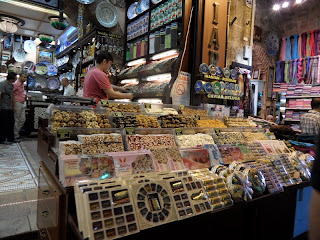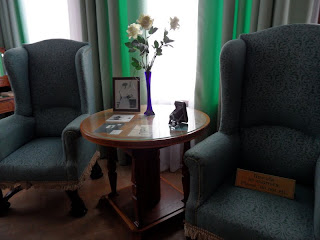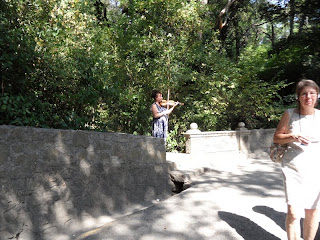This is the final blog post. After this post, this blog is over. This is kind of sad.
It's really been quite the summer, and I wanted to thank you all for keeping up with this for so long. I really appreciate it. You have followed me across three months and as many continents and it really means a lot to me.
But this blog is not only a testament to three months of globetrotting, but a testament to your multiculturalism. Check this out...
That first one is my page views by country for all time, and the second is for just this months. Seriously, you guys are from all over! Of course the majority of you have viewed the blog from the states. I'm an American and my friends are mostly American and they have very kindly been keeping up with my blog. However, you people have viewed my blog from, among others:
Argentina
Uruguay
United Kingdom
France
Puerto Rico
Germany
Canada
Mexico
Switzerland
India
Singapore
Australia
Latvia
Norway
Wow.
So I just wanted to thank you all for keeping up with me for so long. But you're not off the hook. I'm moving over to another blog which I would hope that you keep up with just as loyally and internationally as you have with this blog. The blog is called Paradigm Shift and the Amazingly Bizarre Capabilities of Consciousness (credit where credit is due to my dear friend Greg for the name), which is slightly long but to my liking; so you should just book mark it now for easy access (hint hint nudge nudge).
Again thank you all for your readership. Hope to see you on Paradigm Shift!
A Summer Abroad
Buenos Aires, Cambridge, the Black Sea. Three Continents. Unlimited Possibilities.
Wednesday, September 7, 2011
Monday, September 5, 2011
Constantinople
September 3,
2011
This was not
my first trip to Istanbul so I hit some things that I didn’t get to see on my
last trip (which covered the big sites); y’all will have to hear all about the
Blue Mosque and Topkapi Palace from another 16-year-old travel blogger. I spent the last day of my vacation in
the city of Istanbul, the only city to be split between two continents. My boat docked in Asia and I took a
taxi to Europe, although you wouldn’t know it. The European side of Istanbul looks much more Middle Eastern
than the very European Asian side of the city. Although I suppose that’s a function of its history. I stayed in the Crowne Plaza in the Old
City, something that I probably will never do again given the lack of food
choices and generally out dated feeling.
Also the poor service.
That’s enough to drive anyone off a hotel.
In any event
I started my day off in the spice market.
This, unlike the Grand Bazaar, feels like a slice of a real Turkish
bazaar. Which is to say that Turks
shop there. Of course you can buy
the junky t-shirts and “Turkish Souvenirs” but there are also plenty of shops
that seem really legit. I found
some great scarves and took some great photos of the piles of spices that line
the alleyways of the market.
Afterwards I
walked over to the Archeological Museum, which is really a complex of
museums. It’s really quite
nice. I grabbed a Fanta in the
museum café and sat in the shade surrounded by roman columns. The special exhibits I saw were
definitely the highlight. One
covered a necropolis from a nearby city and the other covered Istanbul’s
imperial history. The second took
you through the timeline of emperors who ruled this city. The museum itself was interesting too,
although not the best archeological museum I’ve ever been in. I personally thought it was well laid
out and the display cases were well labeled, which is more than can be said for
some museums I’ve been in.
Finally I
hit the Grand Bazaar. This
labyrinth of stalls hawking fakes and treasures is utterly overwhelming. But it doesn’t give you the feel of a
real bazaar. The shops are permanent facades often very nicely displayed behind
glass windows. To me, this screams
commercialized fake. I liked the
selection of goods better in the Spice Market too, even though it was
smaller. I’m not saying don’t go
to the Grand Bazaar, it’s probably an integral part of any trip to
Istanbul. I’m just saying I don’t
really like it. And I like
markets.
The Palaces of Yalta
September 1,
2011
Yalta’s
palaces are not just any palaces; Yalta’s palaces are where the Yalta
Conference took place. So I have
walked through halls once occupied by Stalin, Roosevelt, and Churchill. I feel cool on so many levels.
Lets start
with Livadia Palace as I did on my tour.
It was built in the beginning of the 20th century as the
summer palace of Czar Nicolai II and in 1945 played host to the main functions
of the Yalta (or Crimean as they say in the Ukraine) Conference as well as the
American delegation since FDR, being slightly crippled at the time, had to be
near the main functions in order to attend. At this conference many important decisions were laid out
including the outline of the United Nations Organization, the answer to the
“Polish Question” of vital importance to Stalin as it outlined the borders of
the democratic buffer zone between the USSR and Germany, and the role Russia
would play in the Pacific Theater after the Europe Theater had been laid to
rest. The Conference was closed
with the signing of the Declaration of Liberated Europe in alphabetical order
after Stalin, citing the fact that it would be rude for the representative from
the host country to sigh first, declined the honor. Interestingly, the palace had been pretty much destroyed by
the Germans on their way out of the Crimea so it had to be prepared for the
conference proceedings but was not fully restored until much later. The Palace is still used for
international summits, which must be seriously cool to attend given all the
history involved.
And now fun
facts! The youngest attendee of
the conference was the American ambassador to the Soviet Union who was only 35
at the time (Imagine being able to tell your grandkids about that time you were
in the same room as FDR, Stalin, and Churchill. Hell, imagine being able to tell your grandkids that you
personally knew a premier of the Soviet Union!). Also included on the guest list were the daughters of the
leaders of the conference. Stalin
was a widower at the time (which may or may not have been self imposed after
his wife was sent by “someone” to the gulag for speaking out against his
treatment of the Kulaks) so none of the delegates brought their wives
out of respect. The picture of the conference (I
didn’t totally catch the name but the title seemed to me to be pronounced Verestroika)
was taken in the central court yard on three separate chairs, so don’t piss off
your guide by asking him or her to show you the bench.
However the
history of Livadia Palace is not all Yalta Conference all the time. It was originally bought by Czar
Alexander II (he’s the cool one who freed the serfs) in 1861 but it was rebuilt
by Nicolai II later on, a czar primarily famous for being the last czar. He and his family only got to visit it
four times, for the first time in 1914 and for the last time in 1917, the year
of the revolution. Interestingly,
the palaces of the Czars are traditionally divided into “His” and “Hers”
sections of the building. We got
the opportunity to see the bedroom of the two monarchs, the Czar’s study, and
the Czarina’s boudoir. Czarina
Alexandra was a bit power hungry.
She wanted to be like the absolutists of old and consolidate power for
her son, but this sadly pissed off her people who already didn’t like her for
her associations with Rasputin and for her German heritage (in fact she was
descended from the Saxcoburgs that Queen Victoria of England was also descended
from). The final Czars asked to be
kept in Livadia Palace after the second revolution, but this request was
denied. The house in the East in
which they died was consecrated as a cathedral in their memory. The Palace was nationalized and turned
into a museum in 1925. Please
enjoy some pictures…
The
Swallow’s Nest palace was built by a German living in Russia for his Gypsy
mistress. It is a kind of symbol
of Yalta in the way that the symbol of New York City could be said to be the
Empire State Building or the Statue of Liberty (which is technically in New
Jersey). Which is to say it’s on
all the post cards. Nowadays its an Exhibition Hall and an over priced and not
very good Italian Restaurant.
Vorontsov
Palace, or The Alupka Palace, was the home of the Main Administrator or the
Crimea under the reign of Catherine the Great. Vorontsov trucked in Edward Blore, 80,000 serfs, and a
German Botanist to design and build the house and the guardens
respectively. In the palace hangs a plaque
commemorating the ten most talented serfs one of which, Роман Фуртуноѵ (I never
caught the pronunciation, but she pointed out the spelling to us), hand crafted
all the plaster decorations in the palace. Which is kind of a big deal since no room is the same as any
other room and there’s one room, which is covered in plaster flowers that
supposedly do not repeat at all.
The palace itself is a combination of Tudor and Moorish styles. I know that sounds incredibly strange,
but it actually works surprisingly well.
Count Vorontsov wanted a unique palace and he certainly got one. This palace also played host to
Churchill and his delegation during the Yalta Conference as well as to the
meetings of the Foreign Affairs ministers not attended by the Big Three. Churchill became especially fond of one
of the many lion statues that adorn the palace and surrounding parks called
“The Sleeping Lion”, saying that it looked just like him but without the
cigar.
I leave you to
enjoy the rest of the pictures. If
you’re interested in any more little stories about the Yalta Conference and
Yalta itself, please ask away in the comments. It tells me in my inbox if you comment and I check my email
very regularly.
Subscribe to:
Comments (Atom)






















































